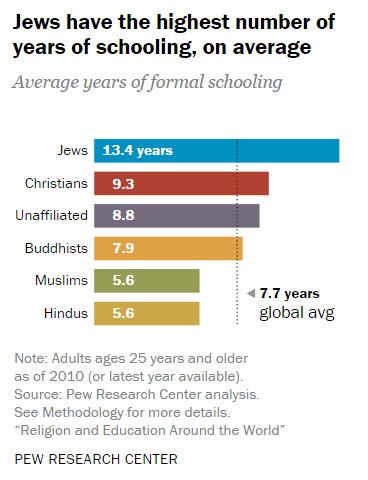IIt's a classic scene for a joke – a priest and a rabbi walk into a bar…. But according to a recent Pew Research Center studyin the United States it is more likely that a Hindu, a Jew, and a Muslim will all fit into a university lecture hall.
Jokes aside, studying for Religion and education around the world claims that religious minorities in the United States are far more likely to have college degrees than their Christian counterparts. The finding is surprising given that, globally, many of these same minorities struggle more with educational attainment.
A different story around the world
While members of minority faiths seem to be shining in the US, their outlook is bleaker around the world. Many receive no formal education. 41 percent of Hindus and 36 percent of Muslims have not been to school.
Christians, Buddhists and the religiously unaffiliated tend to fare better, with more than 50 percent having at least a secondary education.


These discrepancies can be explained by the economic situation of different locations around the world. Outside the United States, Hindu and Muslim populations are largely concentrated in developing countries.
Ninety-eight percent of adults who identify as Hindu live in India, Nepal or Bangladesh. There are large Muslim populations in sub-Saharan Africa and the Middle East. These countries have high rates of poverty and it is often difficult for families to provide all the assets needed to educate children.
It is worth noting that Muslims living in Europe tend to acquire a higher level of education than Muslims in the Middle East.
Jews, on the other hand, are concentrated mainly in the United States and Israel. Both countries have strong economies, which means parents often have the means to help their children achieve higher levels of education.




Highest performance in the United States
Almost all Hindus (96 percent) and the majority of Muslims (54 percent) over the age of 25 in the United States have earned a bachelor's degree or higher. This is more than the Christian majority, which stands at 36 percent – 3 percentage points below the national average.


Eighty-seven percent of Hindus and 64 percent of Muslims living in the United States today were not born here, compared to only 14 percent of Christians within the United States.
In addition, immigration policies in the United States tend to favor highly skilled applicants. As shown in the chart below, more than half of the visas granted to highly skilled workers come from India, home to 90 percent of the world's Hindus.

The survey also showed that Asian Americans — including people from India, a majority Hindu and Muslim country — are among the wealthiest and most educated immigrants in the United States.
There is also a strong correlation between parents' education and their children's academic performance. These parents not only value education but also have the resources to enroll their children in better schools, tutoring and extra courses.
Hindus and Muslims around the world are coming together


In three generations, the percentage of Hindus with some education has risen from 43 percent to 71 percent. Muslims with at least some education increased from 46 percent to 72 percent during the same period.
These gains also reflect a narrowing of the gender gap in education across all faiths.
Maybe the next generation joke involves two Hindu and Muslim professors walking into a nail salon.



